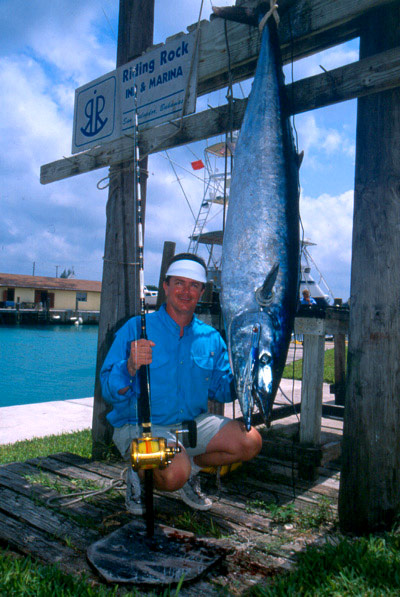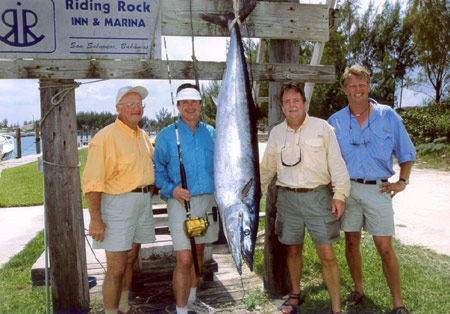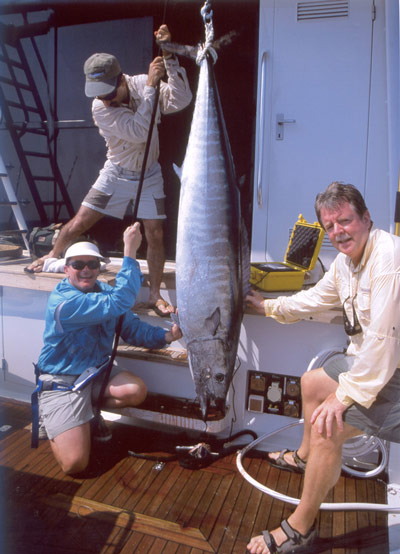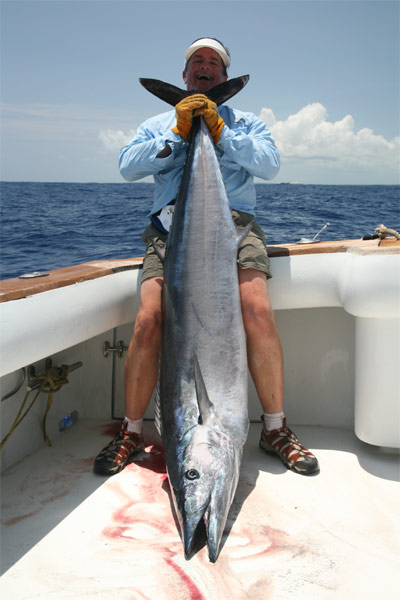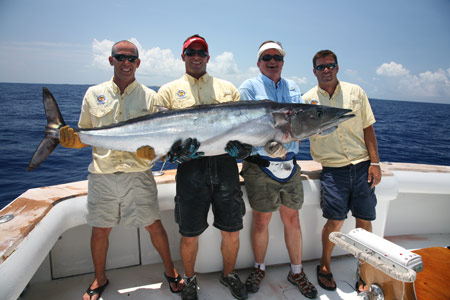Watch Video Of Fish Being Caught At Bottom Of Each Article
WAHOO #1 - THE 143.3 POUND SAN SALVADOR, BAHAMAS WAHOO!
Displaying experience gained from his many years of fishing the Bahamas, Captain George Gardner kept the Foxy Lady II, a 58-foot Striker, moving forward at a few knots in an effort to pull the fish away from the peak of a seamount that rose to within 180-feet of the surface. We needed to get it into open water to avoid the sharks, a real problem in the waters off San Salvador.
When the fish was safely sulking in over 4,000 feet of water, Gardner stopped the boat, which enabled me to start gaining line. After 30 minutes of strenuous pumping and winding, I had the huge ‘hoo within 50 yards of the boat. And just when I was convinced it might be ready for the gaff, it took off on its second run. Ten more minutes passed until I could lead the fish alongside the transom, where it was gaffed and slid through the cockpit door. It was enormous! We all gawked at its size, then the celebration started.
Back at the marina, the fish registered a whopping 143.3 pounds, with a length of six feet, six inches and a 36-inch girth. That’s one hefty ‘hoo!
HOME OF THE ‘HOO - When the target is big wahoo, the remote island of San Salvador in the Bahamas is the place to be between December and April. This is when scores of wahoo migrate through the local waters, with most running 50 to 60 pounds. If those numbers don’t excite you, there are enough triple-digit fish around to provide a decent chance at tangling with one. In fact, San Salvador gave up five of the current IGFA line-class records, including the Woman’s 130-Pound Class (113 pounds), Woman’s 80-Pound Class (132 pounds), Woman’s 50-Pound Class (153 pounds, eight ounces), Woman’s 16-Pound Class (74 pounds), and the Men’s 80-Pound Class (155 pounds, eight ounces). And on the same day we took our big fish, local captain Floyd Dorsett decked a fish weighing 130 pounds.
Located approximately 400 nautical miles from South Florida, San Salvador is allegedly the first island Christopher Columbus set foot on during his 1492 voyage. More recently, however, it’s the wahoo fishing that has been making history here. Although the 12-by-six-mile island doesn’t attract a lot of fishermen because of its remoteness, more and more big boats are showing up each season to try their hand at some of the world’s best wahoo fishing.
It was the anticipation of hooking an 80- to 100-pound-class wahoo, plus fast action with 50- to 60-pounders, that inspired me to make the trip to San Salvador with friend Ray McConnell, who owns Ray’s Offshore Tackle in Boca Raton, Florida. Our host was Don Strom, owner of the Foxy Lady II, a Boca Raton-based sportfisherman captained by George Gardner. Riding along to assist the team was Strom’s friend, Howard Donhauser. Strom and Gardner are regulars on the San Salvador wahoo grounds. Before joining Strom, Gardner worked as divemaster at the Riding Rock Marina, where we stayed during our visit. Needless to say, both men know where and when the fish tend to stack up.
Displaying experience gained from his many years of fishing the Bahamas, Captain George Gardner kept the Foxy Lady II, a 58-foot Striker, moving forward at a few knots in an effort to pull the fish away from the peak of a seamount that rose to within 180-feet of the surface. We needed to get it into open water to avoid the sharks, a real problem in the waters off San Salvador.
SHARK STRATEGY - Sharks can be a major nuisance when wahoo fishing. To decrease the time spent fighting a wahoo, and therefore the odds of a shark attacking it, we fished five Penn International 70s spooled with 80-pound test line. Should a hookup occur on top of a hump, a good trick is to steer the boat toward deep water to pull the fish away from the shark-infested structure.
Shortly after Ray and I flew back to Florida, Don Strom rejoined his crew and hooked another monster wahoo, only to lose most of it to a huge shark. Based on the size of the head, the fish was estimated to have weighed around 130 pounds.
Even on heavy tackle, San Salvador harbors some wahoo that can be a challenge to stop. Gardner and Strom tell me they have hooked two wahoo that completely stripped 80-pound class reels on the initial runs. They now fish 130-pound class tackle with their sites set on stopping the next all-tackle world-record wahoo. While that may sound a bit presumptuous, the odds of it happening in the waters off San Salvador are really pretty good.
WAHOO #2 - THE 113.2 POUND SAN SALVADOR, BAHAMAS WAHOO!
Our base was once again the Riding Rock Resort and Marina. And while the wind was on the breezy side when we set forth, it was certainly fishable.
Most of the fishing effort takes place over a hump situated off San Salvador's northern end. From the Riding Rock Marina, located on the island's western side, it's roughly a 30-minute run to cover the ten miles to the hump, which rises to 180 feet from a surrounding depth of approximately 4,000 feet. Like most seamounts in the Bahamas, this hump attracts schools of tuna, wahoo and big, big sharks! Just off the hump, in deeper water, you'll find dolphin. And, of course, billfish are a distinct possibility anywhere here! The peak fishing season for wahoo is November through March, while dolphin, tuna and marlin show in numbers from April through June.
The fishing off San Salvador was on fire. It was fast action, with little time to rest, or even scarf down a sandwich — exactly the way a person hopes to find the fishing on such a trip. We even caught a small sailfish, which was promptly released at the transom.
With a successful show in the can, and plenty of tired arms, legs and backs from battling tuna and dolphin, we decided to put out a spread of marlin lures and troll back to the marina. We nearly made it! About three miles away, Trey hooked into a big dolphin. We cleared the lines and I eventually gaffed a beautiful 30-plus pound bull dolphin. After depositing the dolphin into the fish box, Joe Trainor brought us back up to trolling speed and we were all dropping lures back into the spread. I paid out one lure and went to the opposite transom to help dispatch another one. Thomas had put a blue and white Rick's Fancy lure back into position off the port outrigger. He was running the release clip up the outrigger, when something huge hit. Thomas passed the rod to me, and all I could do initially was hold on!
NEVER WOULD HAVE GUESSED? - Considering its long run and weight of the fish, I guessed it to be a small blue marlin, maybe around 100 pounds. The fish occasionally angled to the surface, where I was expecting it to jump. It never did. It eventually dove deep. Given the vertical give and take fight we settled into, Trey called it as a yellowfin tuna. I still banked on a marlin, since the fight was different than a tuna.
Toward the end of the fight, the fish was nearly straight beneath the boat and deep enough where we couldn't see it. A shark suddenly appeared off the transom, so, in a semi-panicked state, I really put the pressure on the fish. There was no way a shark was going to steal this fish. As the leader came into view, Joe bumped the boat forward in an attempt to lead the fish in alongside the starboard side. It was then when I heard Trey yell — "It's a wahoo! It's a huge wahoo! Get a gaff"
Of course, hearing that, and keeping one eye on the shark off our transom, I kept cranking on line. I caught a glimpse of the fish, while it was out of gaffing range, and nearly freaked out. From that moment on, everything seemed to go into slow motion. In what really took only 30-seconds or so to sink a gaff into the fish and lift it over the transom, seemed more like a half hour. Once the huge fish hit the deck, only then did it sink in that we boated a monster wahoo — and just minutes away from Riding Rock Marina!
Talk about an incredible ending to a trip! Here we were, during the spring and past the peak wahoo migration, and I score another big wahoo. On the marina scale, this fish weighed 113 pounds, 2 ounces.
Talk about luck! I've been to San Salvador just twice and each time I've scored a wahoo over 100 pounds! Yes, indeed. I wish San Salvador would establish a lotto. I'm quite sure I'd win it. For some reason, this island smiles upon me!


